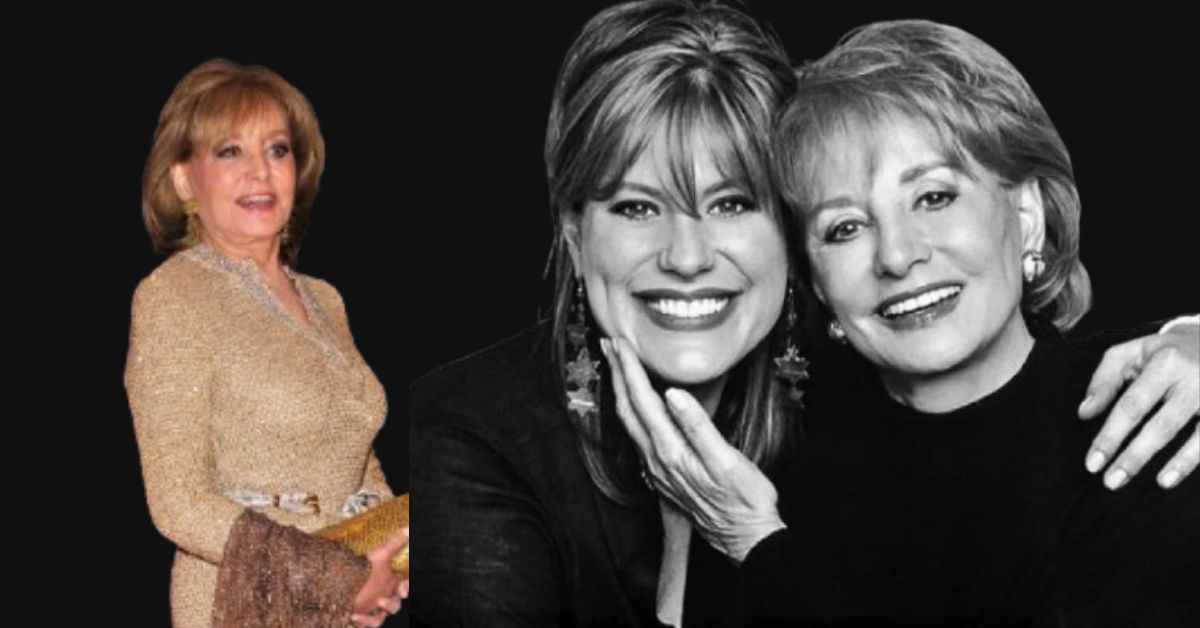In the glittering world of American media, where fame often overshadows substance, one woman chose a dramatically different path. While her younger sister Barbara Walters became a television journalist icon who transformed broadcasting forever, Walda Walters Anderson deliberately stepped away from the spotlight to forge her own meaningful legacy. This broadcast journalist’s sibling represents something rare in our celebrity-obsessed culture: a notable figure who found profound fulfillment in private life rather than public recognition.
Her story reveals the emotional truth behind one of America’s most influential media families. The Walters Family dynamic created not just one legendary media icon, but a supportive sibling whose quiet strength became the foundation for extraordinary success. Walda Walters Anderson embodies what true family support looks like when fame threatens to overshadow authentic relationships.
This is her complete story – told with the dignity and depth she deserves.
Who Is Walda Walters Anderson? All You Need to Know
Walda Walters Anderson stands as one of American media’s most fascinating unseen presence figures. Born into The Walters Family during the late 1930s, she chose to become a communications executive rather than pursue the television spotlight that made her younger sister Barbara Walters a household name. Her decision to maintain a low profile throughout her life speaks to a different kind of strength – one that values authentic relationships over public recognition.
Her family background shaped not just her character, but indirectly influenced the entire landscape of American media. As a family member who understood the cost of fame, Walda provided the emotional stability that allowed Barbara Walters to take the risks that revolutionized journalism. Her professional career as a communications executive demonstrated that meaningful impact doesn’t always require cameras and applause.
Quick Facts About Walda Walters Anderson
Walda Walters Anderson was born in the United States during the late 1930s to Lou Walters, a charismatic nightclub owner and Broadway producer, and Dena Seletsky Walters, a resilient homemaker of Jewish-Russian descent. Her cultural background and ethnic heritage deeply influenced her values of loyalty, family support, and quiet dignity that would define her entire life.
Her familial relationships extended beyond her famous younger sister Barbara Walters to include Jacqueline, a beloved sister with developmental disabilities, and Burton, an infant brother whose early death cast a lasting shadow over The Walters Family. These profound family dynamics shaped Walda’s character as a natural caregiver and supportive sibling.
Walda’s professional career flourished in corporate communications, where she built a reputation as a skilled communications executive specializing in public relations and consulting. Her media role behind the scenes allowed her to understand the broadcasting industry while maintaining her chosen privacy. She later became known as Walda Anderson-Izzard, reflecting her commitment to personal life over public recognition.
The Walters Family: Glamour, Grief, and Grit
The Walters Family story begins with Lou Walters, an ambitious parent whose Broadway producer career created both opportunities and instability. His famous Latin Quarter nightclubs in New York and Miami attracted celebrities nightly, making the Walters name synonymous with entertainment glamour. Yet behind this charismatic figure’s success lay financial uncertainty that constantly tested family dynamics.
Lou Walters represented the classic family patriarch of mid-20th century America – driven, charming, but often chasing dreams faster than securing foundations. His nightclub owner business fluctuated with economic conditions, creating a household that oscillated between luxury and anxiety. This upbringing taught all the Walters children that appearances could deceive, and that true security came from familial relationships rather than external success.
Dena Seletsky Walters anchored The Walters Family with her Russian roots strength and traditional values. Her maternal lineage brought stability to an otherwise unpredictable family background. Despite Lou’s ambitious pursuits, she maintained the emotional center that allowed their children to develop strong characters. Her Jewish-Russian descent contributed cultural richness that emphasized education, loyalty, and family support above individual glory.
Siblings: Love in a Fragile Household
The Walters Family included four children whose close bond was forged through shared challenges and mutual support. Walda Walters Anderson naturally emerged as a stabilizing force among her siblings, demonstrating the caregiving instincts that would define her character throughout life. Her sisterhood with Barbara and Jacqueline created an unbreakable foundation of love and loyalty.
The siblings learned early that family dynamics required both independence and interdependence. While Barbara Walters showed early signs of ambition and charisma, Walda provided the emotional grounding that allowed such dreams to flourish. Their family member relationships transcended typical sibling rivalry, instead creating a support system that would sustain them through decades of challenges and changes.
A Brother Lost Too Soon
Burton Walters’ brief life left an indelible mark on The Walters Family. Born with developmental challenges, his early death as an infant devastated the entire household but particularly impacted Walda’s protective instincts. This tragedy taught her that life’s most precious moments often occur away from spotlight, in hospital rooms and quiet conversations where family support matters most.
The loss shaped Walda’s understanding of vulnerability and strength. She learned that caring for others wasn’t a burden but a privilege, and that emotional truth often emerges through grief rather than celebration. This early experience with loss prepared her for the caregiving responsibilities she would later assume with Jacqueline.
Jacqueline: A Bond Beyond Words
Jacqueline lived with severe developmental disabilities that required lifelong family support. In an era when society offered little understanding or resources for such challenges, The Walters Family created their own support system. Walda Walters Anderson naturally assumed primary caregiving responsibilities, demonstrating the loving bond that would define their relationship for decades.
Walda’s devotion to Jacqueline revealed her character’s deepest qualities. She attended medical appointments, managed daily needs, and provided emotional comfort with patience that impressed everyone who witnessed their sisterhood. This developmental disabilities advocacy work never made headlines, yet profoundly shaped both sisters’ lives and demonstrated Walda’s capacity for silent strength.
Barbara and Walda: Sisters First
The relationship between Barbara Walters and Walda Walters Anderson transcended typical sibling dynamics to become one of mutual admiration and support. Despite Barbara’s rising fame in American media, their familial relationship remained grounded in childhood experiences and shared values. Barbara often credited Walda as her emotional anchor, describing her as “my constant connection to who we were before the world knew us.”
Walda’s supportive sibling role provided Barbara with essential perspective during her groundbreaking television journalist career. While Barbara navigated the pressures of broadcasting and public scrutiny, Walda offered the authenticity and genuine narrative that kept her grounded. Their close bond demonstrated that success in journalism requires both public courage and private support systems.
Read Post: Tony Finau Net Worth 2025: From Utah Dreams to PGA Tour Millions
Career: The Quiet Professional
Walda Walters Anderson built her professional career as a communications executive, choosing substance over spotlight in an industry adjacent to her sister’s media world. Her expertise in corporate communications and public relations demonstrated that meaningful impact could be achieved without cameras or headlines. This media role allowed her to understand broadcasting dynamics while maintaining her chosen privacy.
Her consulting work emphasized listening over speaking, strategy over spectacle. Colleagues respected her thorough preparation and ethical standards, qualities that made her exceptionally effective in corporate communications. Walda’s approach proved that professional career success could align with personal values of discretion and dignity. She mentored younger professionals while consistently choosing personal life fulfillment over public recognition.
A Life Off the Radar
Walda Walters Anderson made deliberate choices about maintaining her private life in an increasingly media-saturated world. Her decision to live away from spotlight wasn’t about avoiding responsibility but about defining success on her own terms. This low profile approach protected both her family dynamics and her authentic relationships from the pressures that often accompany fame.
Her privacy strategy required constant vigilance as Barbara Walters became more famous. Walda skillfully navigated media interest while maintaining boundaries that preserved her chosen lifestyle. This unseen presence approach demonstrated that meaningful lives could unfold without public validation, and that dignified presence often achieved more than dramatic gestures in creating lasting memory.
Where Did She Go?
Walda Walters Anderson gradually reduced public appearances as Barbara’s fame intensified, eventually becoming known as Walda Anderson-Izzard in recent years. Her private life choice reflected deeper values about family history and authenticity over celebrity culture. Evidence suggests she focused increasingly on family support roles and personal life fulfillment rather than public recognition.
Recent traces indicate a woman who found peace in privacy, describing herself as a widow, mother, and grandmother with the telling bio quote: “Kindness should never be mistaken for weakness.” This statement captures her legacy of quiet grace perfectly – strength that doesn’t need to announce itself but speaks through consistent actions and enduring impact.
Key Relationships That Shaped Her
Walda Walters Anderson’s life was defined by the quality of her relationships rather than their quantity. Her marriage brought the Anderson surname while maintaining Walters family connections, reflecting her ability to honor both chosen and birth families. Her approach to relationships emphasized authenticity and mutual respect over social status or public benefit.
Her family dynamics remained central throughout her life, from caregiving for Jacqueline to providing emotional support for Barbara’s career challenges. Professional relationships were built on trust and discretion, creating a network that valued her judgment and integrity. Walda understood that lasting memory emerges from consistent family support rather than momentary recognition.
Her Impact, Though Quiet, Was Never Small
Walda Walters Anderson’s influence on American media came through her supportive sibling role rather than direct participation. Her emotional support during Barbara Walters’ most challenging career moments provided the stability necessary for groundbreaking journalism. This unseen presence contribution to television history demonstrates how silent strength often enables public achievements.
Her professional career as a communications executive influenced numerous organizations and individuals through ethical corporate communications practices. Walda’s legacy of quiet grace includes mentoring younger professionals and contributing to industry best practices without seeking credit. Her dignified presence showed that enduring impact could be achieved through consistent values rather than public recognition.
Final Reflection: A Legacy of Quiet Grace
Walda Walters Anderson represents an alternative definition of success that prioritizes emotional truth over public recognition. Her heartfelt story demonstrates that choosing privacy can be a form of strength rather than retreat. In our social media age, her example of understated influence offers valuable lessons about authentic living and meaningful relationships.
Her family history contribution to American media occurred away from spotlight but proved equally essential to the industry’s development. Walda’s sincerity and commitment to family support created the foundation that allowed Barbara Walters to take the professional risks that revolutionized broadcasting. This true portrayal of her life reveals how silent strength often achieves more than loud ambition.
The Walters Family story wouldn’t be complete without Walda’s chapter of quiet grace. Her choices validated different paths to fulfillment and demonstrated that notable figures can emerge from private life rather than public stages. Her legacy reminds us that behind every media icon stands someone who made space for their success through understated influence and loving bond support.
FAQs About Walda Walters Anderson
Is Walda Walters Anderson still alive?
Walda Walters Anderson appears to be living as of 2025, though she maintains strict privacy about her current circumstances.
What did she do professionally?
Walda Walters Anderson worked as a communications executive specializing in corporate communications, public relations, and strategic consulting.
Why is she not in the public eye like Barbara?
Walda Walters Anderson deliberately chose private life over public recognition, prioritizing authenticity and family support over fame.











